Danny in Elementary School (Grades 4-6): 1956-1959
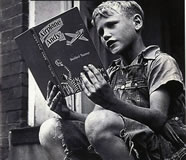 Danny’s elementary school experience is influenced by:
Danny’s elementary school experience is influenced by:
1. His reluctance to engage in reading skills
2. His brothers as learning mentors
3. A gift from his mother
4. A trip that includes visits to historic sites
Questioning and Exploration
Danny is a very reluctant reader. He would rather explore through hands-on projects and news events presented on the new black and white television his parents purchased in 1957. He lives in a small town in southern Kansas.
 Similar to nearly all children, Danny is curious. He is also active in lots of athletic activities, especially little league baseball, and is a member of the local 4-H and Cub Scouts. His most concentrated efforts to read involve brief descriptions and extensive statistics on hundreds of baseball cards.
Similar to nearly all children, Danny is curious. He is also active in lots of athletic activities, especially little league baseball, and is a member of the local 4-H and Cub Scouts. His most concentrated efforts to read involve brief descriptions and extensive statistics on hundreds of baseball cards.
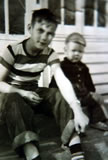 Two major “information mentors” for Danny are his older brothers. Keith is ten years older and can seeming solve all technical problems. Schematic plans are deciphered as Keith constructs model airplanes and cars, repairs his own car and can create his own plans for building nearly anything. Danny’s oldest brother does not care for literature or an academic-based world, but seems to excel in consuming technical information to solve real-life problems.
Two major “information mentors” for Danny are his older brothers. Keith is ten years older and can seeming solve all technical problems. Schematic plans are deciphered as Keith constructs model airplanes and cars, repairs his own car and can create his own plans for building nearly anything. Danny’s oldest brother does not care for literature or an academic-based world, but seems to excel in consuming technical information to solve real-life problems.
Danny’s second older brother is a veracious reader. Norman especially prefers mysteries and dramas. To Danny’s enjoyment, Norman reads to his younger brother on nearly a daily basis. Norman seems to bring characters to life as he reads, often providing his own interpretations of situations and inflections of various voices. Never really “tied to a script”, Danny’s older brother of seven years, tells a story “with gusto” and reads aloud selected details and descriptions from the text. He often uses literary license allowing for more entertaining interpretations.
Few areas of study in elementary school interest Danny. One topic in the fourth grade, local Kansas history, seems not only perplexing, but also personal and therefore of special meaning. Most reading in school is from Basil collections that do not tell a story, but simply repeat similar words. Danny is always placed in the “robin group”, third after the better “blue bird” and “red bird” groups. Such never bothers him as the two better groups are filled with girls.
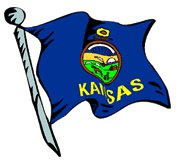
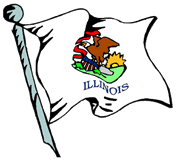
A family vacation to Illinois, the summer following fourth grade, introduces Danny to the artifacts and stories found at the home of Abraham Lincoln. The trip also involves stops in Lawrence and Pottawatomie. These Kansas communities are locations of conflicts leading to the Civil War. Materials obtained from these historic sites and more books from the public library selected by Norman help to focus on issues and conflicts that seem to Danny to be meaningful to explore.
 By the end of the fifth grade and after the many projects available in 4-H and Cubs, one seemed of special interest to Danny. Collecting stories, photos and cartoons into his own newspaper was as near as he could get to the news reports he watched on television. His mother found a unique duplication device based on a gel that would carry ink on its surface from a written master. Up to fifty reproductions could be pulled from the gel base, including the use of different colors using a variety of pens. His mother gave Danny one of these printing plates. The crude device proved to be efficient after Keith made some modifications.
By the end of the fifth grade and after the many projects available in 4-H and Cubs, one seemed of special interest to Danny. Collecting stories, photos and cartoons into his own newspaper was as near as he could get to the news reports he watched on television. His mother found a unique duplication device based on a gel that would carry ink on its surface from a written master. Up to fifty reproductions could be pulled from the gel base, including the use of different colors using a variety of pens. His mother gave Danny one of these printing plates. The crude device proved to be efficient after Keith made some modifications.
Danny entered the sixth grade with his first “Tip Top Times” newspaper printed and ready for free distribution. On a single page divisions were provided for a cartoon, sports facts, and the coming Kansas Centennial in 1961 (http://www.kshs.org/publicat/khq/1965/65_1_staff.htm).
Not all of Danny’s classmates displayed interest. Those who did were soon contributing their own drawings, poems and stories. Seven more issues were published before the end of the school year. For a small group, the newspaper set the stage for the centennial celebration that was to follow in junior high school.
The time and energy to gather information for these issues involved an exploration of many new topics and lots of additional reading. Almanacs and encyclopedias helped along with lots of material found under Kansas History in the public library vertical file. Among the key terms leading to topics of interest were:
- Jayhawk – Myth or True Historical Symbol? (http://www.ku.edu/about/traditions/index.shtml )
- Buffalo – Where are They? (http://www.pbs.org/wnet/nature/buffalo/nation.html )
- Ad astra per aspera – What does our Motto Mean and What Else is on the Seal?
- The Kansa Indians – Why are They the Wind People? (http://www.kshs.org/places/kawmission/kansaorigins.htm )
And the burning sports question even in 1960, “Who is Better Mantle or Mays?” (http://www.suite101.com/article.cfm/yankees_no_more_no_less/73982)
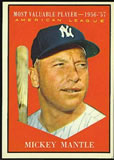
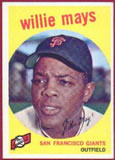
There could be no conclusive argument as both were in the middle of their magnificent careers, however one could certainly compare numbers from what was summarized on their baseball cards.
Assimilation & Inference
As a struggling reader, Danny needed a reason or specific purpose to explore information and read deeper. As an emerging information scientist, he was learning to formulate questions of interest to him and to others. With guidance from others, mostly friends and relatives, he was learning where additional information was housed.
Danny was beginning to apply information to create a story to inform others. Although he was not mature enough to understand the issues behind the historical conflicts that are a part of his home state’s history, he was beginning to touch on these through his readings and discussions. These names and events would be only facts at this stage, but over the next ten years they would become key terms to link to many other sources of information about human conflicts and compromises.
- Bleeding Kansas – Did the Civil War Start in Our State? (http://www.nps.gov/fosc/historyculture/bleeding.htm)
- William Clarke Quantrill – Punk or Patriot from Missouri? (http://www.pbs.org/weta/thewest/people/i_r/quantrill.htm )
- John Brown – What is Justice: Was He Right or Wrong? (http://www.pbs.org/weta/thewest/people/a_c/brown.htm )
- Missouri Compromise – A Solution or Deadly Delay of Conflict? (http://en.wikipedia.org/wiki/Kansas-Nebraska_Act )
- Kansas-Nebraska Act – Can We Settle Conflict With a Vote? (http://en.wikipedia.org/wiki/Kansas-Nebraska_Act )
Reflection
Danny gained some confidence in these early experiences with exploring information sources and assimilating new knowledge. His vocabulary increased, his frequency of reading went up, and the spectrum of documents to explore also increased. The reason, however, was not a grade or chance to move into a higher reading group. The motivation was a product -- a presentation instrument that allowed Danny to not only communicate with classmates, but to also learn through social interaction.
Danny was raised in normal academic environment of his day. His school provided the usual approach to reading instruction of the time. None of the elementary schools in Danny’s hometown housed school libraries and no one had heard of an elementary school librarian. The community did have a good Carnegie Library with the entire basement devoted to materials for children. Danny did participate in the summer reading program, but found the library much more useful when seeking materials to address specific questions. Reading just to be reading was of no interest to him.
Skills. Danny was learning to give focus to inquiry. As new questions are raised the need for new information also emerges. New information and assimilation of knowledge lead to more questions. The newspaper, however, forced some decisions as to selection of information and addressing certain topics. The limited space of the newspaper format, the interest of the readers, and the limitation of the information that was understandable and age appropriate determined the focus and closure on the information inquiry process.
Danny seems to have interest in using information and numbers to build a case or to support an argument. Information can be used to persuade as well as inform. Although Danny as many experiences in front of him to assimilate strategies that influence information selection based on ethics, relevancy and authority, he has established a base for applying information to his communication needs.
Strategies and Scaffolding. Danny was learning to use new sources. Much of this was based on his understanding that he could learn from others. He observed and listened to his brothers, his early learning mentors. He was fortunate to have two siblings who displayed different learning styles, both of which proved useful for him. He has found that he learns best when engaged in an activity with purpose -- something that has tangible and immediate reward.
Realizations. Danny has found that he can learn in a social environment when there are tasks shared among a group. Although he may have interests that are unique to him, he also has interests that are relevant to others. By interacting with his peers, he can learn through leading, sharing and observing.
Standards
Information Literacy Standards (Selected from Information Power, AASL, 1998)
- Organizes and presents basic information related to topics of personal interest.
- Expresses information and ideas creatively in simple formats.
- Identifies several appropriate sources for resolving an information problem or question.
- Works with others to create and evaluate simple information products.
Content Standards
- Understands the unique historical conditions that influenced the formation of the state and how statehood was granted.
- Understands how the ideas of significant people affected the history of the state.
- Understands how songs, symbols, and slogans demonstrate freedom of expression and the role of protest in a democracy.
Mid-continent Research for Education and Learning – Content Knowledge
http://www.mcrel.org/standards-benchmarks/
Developing Education Standards
http://edstandards.org/Standards.html
Times Have Changed
In the past fifty years, black and white broadcast televisions have been replaced by high definition color, wide-screen televisions with thousands of channels of information. In addition to print newspapers, people have access to news through 24/7 television channels and websites. Computers and high-speed copiers have replaced ditto machines. Although the tools Danny used for accessing information and constructing of his newspaper have evolved, his experience in seeking and organizing ideas would be the same today.
If Danny and his brothers were to visit the Lincoln home and museum today, many more artifacts could be examined through interactive exhibits and primary sources available on display and through the Internet (http://www.alplm.org/home.html).
In addition, Danny's experience as a reluctant reader and his lack of concern about reading groups is still typical today. However educators are increasingly aware of the need to address the individual needs and interests of children.
Relevant Resources
Gurian, Michael. 2005. The Minds of Boys: Saving Our Sons from Falling Behind in School and Life. Jossey-Bass. Learn more at the Gurian Institute. Listen to a radio interview of Gurian from the Diane Rehm Show.
Useful links to 4H USA and the project approach to learning they have mastered over the past century are:
4HUSA.org
http://4-h.org/
